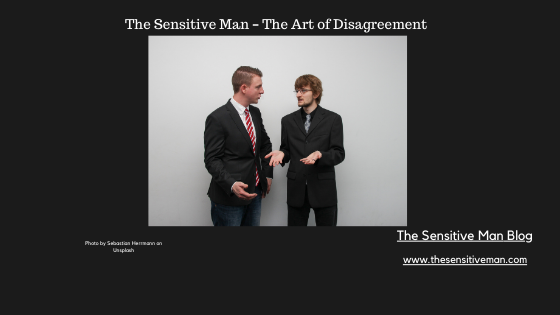|
A Blog about Sensory Processing Sensitivity from the Worldview of a High Sensing Male
Do you remember the last time you were in an argument? How did it go? How did you feel after the argument/disagreement ended? Did you feel heard? Did you get overly emotional or discombobulated? Were you able to defend your position or at least feel you made your point? Or did you feel like your arguing skills were lacking? Probably about a day later, you had thoughts about how you could have taken a position that would have gotten your point across. Perhaps, you thought too late about a clever retort that might have helped you save face in the argument. You may have been bullied into a concession that you didn't want to make. That doesn't feel good. I have often wondered if it was only me or are other HSPs lousy at verbal encounters, especially the ones that get heated. It's like our brains get scrambled with emotion, conflicting signals, and as I said in an earlier post, it went right to fight or flight mode, without any thought, logic, or reason. How do we as HSPs get better at verbal confrontation? Not so much to conquer our opponents but rather to be heard, make salient points, stay genuine and authentic and not turn into emotional cannons, sometimes firing blanks. Can we train our HSP brains to be better at persuasive and unemotional arguments and not get so damn frazzled? I think the answer is yes. It takes some practice, some knowledge, and the willingness to slow down thoughts in our brains. Let's look at a few ways we can learn to master the art of verbal self-defense and construct better arguments in our discussions with others. Suzette Haden Elgin and The Gentle Art of Verbal Self Defense In the 80s, Suzette Haden Elgin wrote a book about verbal self-defense and how to defend against verbal attacks. The book was called The Gentle Art of Verbal Self-Defense. Before the term Highly Sensitive Person was coined, Elgin wrote this book for those of us HSPs and others who found themselves often lacking in verbal self-defense skills. A more perfect book could not have been written for many HSPs' troubles in dealing with verbal assaults. The book's premise was to teach others how to defend against eight common types of verbal violence and defuse and deflect potential verbal confrontations. Elgin was a linguist, author, and professor at the University of California at San Diego and understood the significance of language, body language, and tone in verbal confrontations. What does a gentle verbal self-defense strategy look like? Understanding how our brain functions under the stress of heated arguments is necessary for comprehending why the sometimes hyped-up emotional brain of HSPs works under fire. When we get into confrontational situations, our brains activate the amygdala, which kicks in the fight or flight response. This mode instinctively bypasses the thinking brain. The brain then pumps epinephrine and norepinephrine, hormones that will ignite that feeling of rushing emotion. The heart kicks in, preparing to run or fight, which causes blood pressure to rise, and stress starts to peak. Your breathing quickens, your voice changes pitch, and muscles tighten. At this point, many HSPs begin to panic. The brain is overwhelmed with stressful signals, and logical thoughts scramble. Keeping up with the verbal assault seems impossible as we absorb slight after slight, not quite sure how to respond. We often freeze in an unstoppable visceral reaction. How do we get past this or, better yet, prevent it? How can we set personal boundaries for ourselves and watch for the communication triggers that set off this panicked response? First, we must understand what the triggers are for us. Is it a subtle backhanded comment, backstabbing, or is it more direct, such as yelling, belittling, or abject name-calling? Are you threatened when the attack is too physical, such as violating your space or aggressive posturing? All of these can lead to the triggers that set off the panic response. To move forward with a defense, one must understand how to identify those individuals or situations that incite these hurtful or threatening feelings. Next, we must train ourselves in how to respond to these triggering situations and stay calm. Finally, we must be prepared, even in advance, for knowing what to say in response to threats. These actions will keep us calm and in control. That is the key to controlling panic. Elgin concludes that avoiding hostile verbal exchanges is a matter of both physical and mental health. We all often react without listening to what the other is saying; this causes a mental leap to conclusions, which only escalates the emotion. When nobody's listening, nobody is getting heard. Our natural inclination is to attack back, plead or debate the attack – none of which effectively work under panic mode. We only give the attacker more fuel by employing these strategies. Giving them attention by continued heated engagement is not going to deescalate the situation. The four basic rules she posits are 1) know that you are under attack (you'll know this best by how you feel), 2) know what kind of attack you are facing, 3) know how to make your defense fit the attack and finally, 4) know how to follow through. Strategies include avoiding the situation or person that likely baits you into a confrontation. Once engaged, you can withdraw or ignore the attacker. You can deflect the attacker by changing topics or offer a compromise. Elgin offers several psychological devices, including matching sensory modes with the attacker. People often use sensory language to engage with others. If possible, match the attacker's language style, whether visual, auditory, or kinesthetic. This strategy may not avoid the argument, but it may cause the discussion not to escalate. Watch out for baiting presuppositions in the attacker's statements. Often, they are tied to an outcome that may have no direct relationship to the argument. "If you loved me, you'd take out the trash." The best response is to dismantle the condition, "if you loved me," by stating that you do love the person, letting the condition fall to the wayside. Some of Elgin's other suggestions have to do with staying calm, watching body language for important emotional clues, ignoring presuppositions and conditions, and focusing on two primary strategies: not feeding the attack with attention and responding to emotion with logic, which she calls Computer mode. The training comes in when you learn how not to take attacks personally. For HSPs, emotional overreaction is a natural reaction and inflates our empathy mechanisms. Doing exercises to help keep your brain calm allows the brain to avoid jumping directly into flight or fight mode. This keeps your thinking brain in the game. Learning to pause after the initial attack is critical. Let the energy flow over you and through you – be quiet and wait. Listen attentively, then pause. When you do speak, speak humbly. Make a reciprocal offer after you understand their position. Be selective about the battles you choose and avoid battlegrounds; they have a way of generating fights. If you can get to flow state in the discussion, you will have a greater chance of finding compromise or understanding. By staying calm, you will see things sequentially versus random arrays of disparate thoughts to cloud your thinking—no more scrambled egg arguments. Say less, hear more. Often you can avoid the fray just by being quieter. Bullies want to fight. By ignoring the invitation, you deprive them of that opportunity and you win. Learn to avoid fights that you can't win; these are often fights with manipulators, narcissists, or strangers who have no emotional investment in you. Calm your ego. You mustn't or shouldn't take on all comers. Walking away can be a quiet win. When you do argue, at least do it logically. Paul Graham and His Hierarchy of Argument Paul Graham, a computer scientist, and essayist laid out a model for logical arguments that stacks argument styles into a pyramid, from the lowliest emotional name-calling at the base and at the apex a rational refutation of the central point of your attacker. It is an outline of learning to move from meanness to logical, rational debate. The hierarchy is worth noting for those of us who prefer not to live in the emotional world of ad hominin attacks. The method requires that you listen to your opponent and discern their central point. Ferret through the emotional crap and get to the core of the argument. Do not attack, name call, or retaliate the tone of the opponent. Instead, respond to the argument's substance, don't counter without proof, do not argue in general terms, but be specific, regardless of their emotional baiting. Stay with the central point. This method requires discipline and focus. You may even frustrate them with your logic and calm (remember Spock and Dr. McCoy in Star Trek). It becomes less about winning and more about learning and exchanging ideas. This is a case where less emotion can be better. It's worth considering, especially for us HSPs. Please share your thoughts in the comment section.
2 Comments
|
AuthorBill Allen currently lives in Bend, Oregon. He is a certified hypnotist and brain training coach at BrainPilots.com. He believes that male sensitivity is not so rare, but it can be confounding for most males living in a culture of masculine insensitivity which teaches boys and men to disconnect from their feelings and emotions. His intent is to use this blog to chronicle his personal journey and share with others. Archives
July 2024
Categories
All
|


 RSS Feed
RSS Feed
